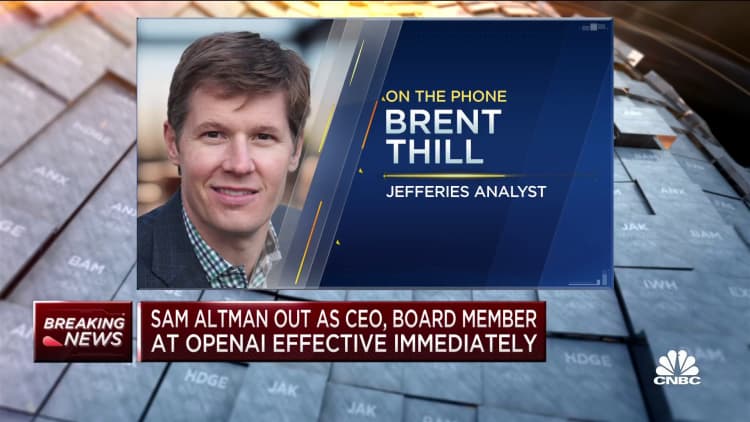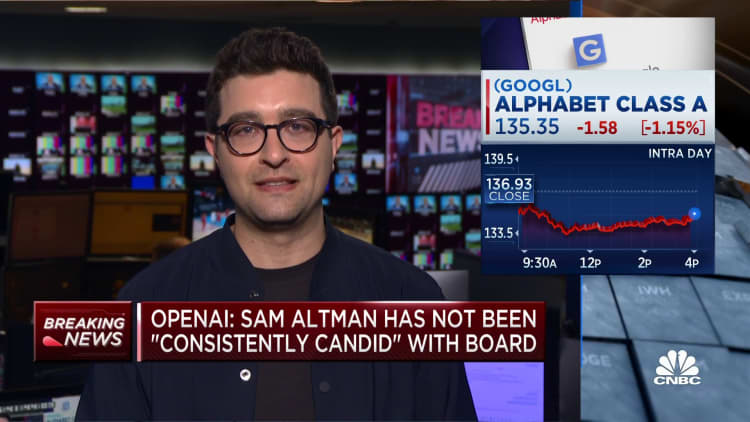
Sam Altman, Chief Executive Officer of OpenAI, and Mira Murati, Chief Technology Officer of OpenAI, speak during The Wall Street Journal’s WSJ Tech Live Conference in Laguna Beach, California on October 17, 2023.
Patrick T. Fallon | Afp | Getty Images
Sam Altman’s sudden ouster from OpenAI on Friday shocked Silicon Valley. Not only was Altman, 38, CEO of the hottest startup on the planet, but he had emerged as the face of generative AI after his company’s ChatGPT chatbot went viral late last year.
From the outside, there were some signs of technological challenges at OpenAI, but no indications that tensions were emerging in the boardroom and the C-suite. Altman was still out and about, proselytizing the value of advanced artificial intelligence while also warning of its potential harms and advocating for regulation.
Just last month, reports surfaced that OpenAI was in talks with investors to sell employee shares at an astonishing $86 billion valuation. That’s after tech valuations corrected dramatically over the past 18 months from the decade-long bull market that was fueled by cheap money and a whole lot of FOMO (fear of missing out).
OpenAI was the industry darling in a time of difficulty. Microsoft was pouring in billions of dollars. The company topped CNBC’s Disruptor 50 list, which was published in May. Shortly before the list came out, Altman told CNBC, “I do think we are deep into a new technological wave and this is, I think, the biggest one in a while.”
That all made Altman’s exit hard to fathom and had some in the tech community comparing the move to Apple’s firing of Steve Jobs in 1985. In a statement on its website, OpenAI said, “The board no longer has confidence in his ability to continue leading OpenAI.” The company named Mira Murati, who was the chief technology officer, as interim CEO.
If you followed Altman for the past two weeks, you would’ve seen an industry leader in the center of the action. Here’s an abbreviated timeline of the days leading up to Altman’s departure:
Nov. 6:
Altman took the stage at OpenAI’s DevDay event in San Francisco, where he announced GPT-4 Turbo, the company’s most powerful AI model. Users were also given access to all of OpenAI’s tools, such as its image-generator DALL-E and PDF upload, within ChatGPT.
At the event, Altman said prices for OpenAI’s software would be cut and individual users could customize ChatGPT. He also unveiled an OpenAI app store, an additional way that the company and its investors could monetize its products.
In a surprise appearance, Microsoft CEO Satya Nadella joined Altman on stage to discuss the future of OpenAI and their partnership. Microsoft committed an additional $10 billion earlier this year, the largest AI investment of 2023, according to PitchBook.
“I think we have the best partnership in tech,” Altman told Nadella onstage. “I’m excited for us to build AGI together,” he said, referring to artificial general intelligence.
Nov. 8:
ChatGPT temporarily crashed in the morning. The chatbot told users that “ChatGPT is at capacity right now” and the update page called it a “major outage.” After a little over an hour, the issue was fixed before experiencing difficulties again later in the day.
OpenAI said in the evening that its issues were related to a denial-of-service (DDoS) attack.
“We are dealing with periodic outages due to an abnormal traffic pattern reflective of a DDoS attack,” the company said.
Issues persisted into the next day before being fixed.
Nov. 14:
Altman posted on X, formerly Twitter, that there would be a pause in signing up for ChatGPT Plus. He said there had been a surge in requests after the DevDay announcements and that usage “has exceeded our capacity and we want to make sure everyone has a great experience.”
Nov. 16:
Altman appeared at the Asia-Pacific Economic Cooperation (APEC) summit in San Francisco, speaking on AI.
At 3:28 p.m. ET on Friday, OpenAI published the blog post announcing Altman’s dismissal. At the same time, the company said Greg Brockman, OpenAI’s president, was being stripped of his role as chairman of the board but would stay on as an executive.
Here’s what happened next:
4:46 p.m. ET:
Altman made his first public statement about his departure, writing on X that his experience at the company was “transformative for me personally, and hopefully the world a little bit.”
7:09 p.m. ET:
Brockman announced on X that he’d quit the company “based on today’s news,” and said he was “super proud of what we’ve all built together since starting in my apartment 8 years ago.”
11:42 p.m. ET:
In an X post, Brockman provided a detailed account of Altman’s removal.
He said that on Thursday night, Altman received a text from OpenAI co-founder Ilya Sutskever asking if they could talk the next day at noon. On Friday afternoon, Brockman wrote, Altman joined a Google Meet with OpenAI board members Sutskever, Tasha McCauley, Adam D’Angelo and Helen Toner. Brockman, who was chairman of the board at this time, wasn’t there.
In the meeting, Sutskever told Altman he was out as CEO. Shortly after that, Sutskever informed Brockman he was being removed as chairman but could remain president. OpenAI’s blog post was released at “around the same time,” Brockman wrote.
He said that it appeared Murati only knew of the move the night before. Altman reposted Brockman’s chronicling of the events.
Nov. 18:
Chief Operating Officer Brad Lightcap sent a memo to OpenAI employees addressing the firing. Lightcap said everyone was caught by surprise at the board’s decision and said Murati “has our full support as CEO.”
“We can say definitively that the board’s decision was not made in response to malfeasance or anything related to our financial, business, safety, or security/privacy practices,” Lightcap wrote.
— CNBC’s Jordan Novet contributed to this report
